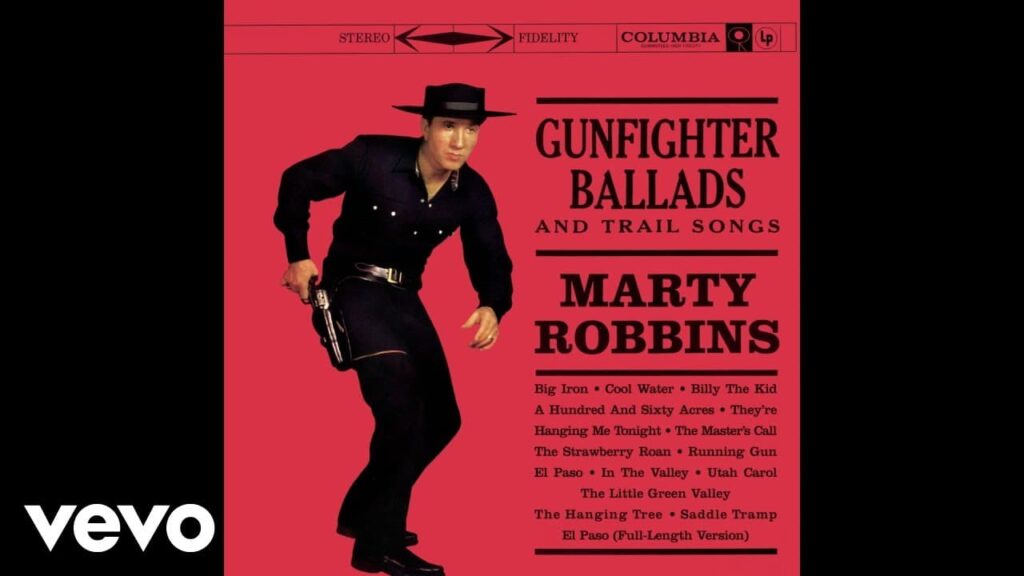
The Legend and the Lore: A Poetic Chronicle of the West’s Most Infamous Outlaw, Echoing Through Time
Marty Robbins‘ evocative and masterful rendition of “Billy the Kid” is not merely a song; it’s a meticulously crafted historical narrative, a cornerstone of his legendary album, “Gunfighter Ballads and Trail Songs”, released in 1959. While “Billy the Kid” was not released as a charting single in its own right, its presence on this iconic album contributed significantly to its monumental success. “Gunfighter Ballads and Trail Songs” was a groundbreaking and hugely successful release, reaching number 6 on the Billboard 200 albums chart and becoming a seminal work that defined the cowboy ballad genre for generations. “Billy the Kid” quickly became a beloved highlight for fans who cherished its authentic portrayal of the American West, its vivid storytelling, and Robbins‘ unparalleled ability to breathe life into historical figures and their often-tragic fates. It solidified Robbins‘ reputation as the premier balladeer of the American frontier, appealing to millions who were captivated by his tales of outlaws, lawmen, and the harsh realities of a bygone era.
The story behind “Billy the Kid” is rooted in the rich, often embellished, history of the American Old West, specifically the life and legend of William H. Bonney, known famously as Billy the Kid. Born Henry McCarty, “The Kid” became one of the most notorious figures of the frontier, a young outlaw involved in the Lincoln County War in New Mexico, whose brief but violent life ended at the age of 21. Marty Robbins was deeply fascinated by Western history, and this passion fueled his creation of the “Gunfighter Ballads” album. Rather than simply recounting facts, Robbins‘ song transforms the historical figure into a character of myth and legend, exploring the romance and tragedy often associated with the outlaw life. He meticulously researched the era, seeking to capture the spirit and the grim reality of the frontier. The song details key events in Billy’s life, from his early exploits to his eventual demise at the hands of Pat Garrett, delivered with a narrative flair that makes the listener feel as if they are sitting around a campfire, listening to a seasoned storyteller. Robbins’ ability to weave historical detail with a gripping narrative made this song, and indeed the entire album, a masterclass in musical storytelling.
The meaning of “Billy the Kid” is a vivid and dramatic chronicle of the life, exploits, and ultimate demise of one of the American West’s most infamous outlaws, exploring themes of fate, rebellion, and the harsh justice of the frontier. It’s a song that humanizes the legendary figure, presenting him not just as a killer, but as a product of his violent environment, destined for a tragic end. The lyrics convey a sense of the inexorable march of fate, as Billy moves from one dangerous encounter to the next, often with a sense of inevitability. Lines like “He was a boy, so very small / He had no chance to grow up tall” capture the poignant tragedy of a life cut short by violence, while detailing his exploits and encounters with the law, particularly Pat Garrett. It speaks to the universal human fascination with anti-heroes, the romanticization of rebellion, and the brutal realities of life and death on the untamed frontier, ultimately serving as a somber ballad of a short, violent existence enshrined forever in the annals of Western lore.
Marty Robbins‘ vocal performance on “Billy the Kid” is nothing short of captivating. His voice, clear, resonant, and possessing an inherent sincerity, tells the complex story with a gripping sense of narrative urgency and a touch of melancholic resignation. He doesn’t merely sing the words; he embodies the character, allowing the listener to feel the dust of the trail, the tension of a standoff, and the inevitable sorrow of a life destined for a violent end. The instrumentation, characteristic of the iconic “Gunfighter Ballads” album, is sparse, traditional, and incredibly atmospheric. A prominent acoustic guitar drives the narrative, complemented by subtle, almost cinematic, percussion and the occasional dramatic flourish that underscores key moments in Billy’s story. This clean, unadorned production allows Robbins‘ expressive voice and the song’s compelling narrative to resonate deeply, creating an incredibly immersive and memorable listening experience that has cemented its place as a definitive telling of the Billy the Kid legend in song form.
Listening to “Billy the Kid” today evokes a particular kind of profound nostalgia, transporting us back to a romanticized yet harsh vision of the American frontier, where legends were born and lives were lived (and lost) by the gun. It reminds us of Marty Robbins‘ unparalleled gift for storytelling and his ability to encapsulate the human spirit within the grand narratives of history. For those of us who recall its pervasive presence from his seminal album, this song remains a cherished gem, a timeless anthem for the outlaws and legends of the West, and a haunting reminder of lives shaped by destiny and danger. It’s a melody that, even after all these years, continues to resonate with its vivid truth, gently reminding us that in the dusty annals of history, few figures are as enduringly captivating as the legendary “Billy the Kid.”